Spatial Differentiation and Influencing Factors of Water Pollution-Intensive Industries in the Yellow River Basin, China
Abstract
:1. Introduction
2. Materials and Methods
2.1. Study Area
2.2. Data Sources and Processing
2.3. Methods
2.3.1. Water Pollution-Intensive Index
2.3.2. Standard Deviation Ellipse
2.3.3. Kernel Density Estimation
2.3.4. Geographically Weighted Regression Model (GWR)
3. Results
3.1. Spatial Differentiation of WPIIs
3.1.1. Scale Characteristics
3.1.2. Directional Distribution Characteristics
3.1.3. Spatial Proximity between WPIIs and Rivers
3.1.4. Kernel Density Analysis
3.2. Analysis of Influencing Factors
3.2.1. Variables Selection
3.2.2. Results of Regression Models
4. Discussion
5. Conclusions
Author Contributions
Funding
Institutional Review Board Statement
Informed Consent Statement
Data Availability Statement
Conflicts of Interest
References
- Kahn, M.E.; Li, P.; Zhao, D. Water pollution progress at borders: The role of changes in China’s political promotion incentives. Am. Econ. J. Econ. Policy. 2015, 7, 223–242. [Google Scholar] [CrossRef] [Green Version]
- Li, P. To Make the Water Safer. Expo. Health 2020, 12, 337–342. [Google Scholar] [CrossRef]
- Huang, Y.; Sui, Q.; Lyu, S.; Wang, J.; Huang, S.; Zhao, W.; Wang, B.; Xu, D.; Kong, M.; Zhang, Y.; et al. Tracking emission sources of PAHs in a region with pollution-intensive industries, Taihu Basin: From potential pollution sources to surface water. Environ. Pollut. 2020, 264, 114674. [Google Scholar] [CrossRef] [PubMed]
- Lu, D.; Sun, D. Development and management tasks of the Yellow River Basin: A preliminary understanding and suggestion. Acta Geogr. Sin. 2019, 74, 2431–2436. (In Chinese) [Google Scholar]
- Hu, J.; Liu, Y.; Fang, J.; Jing, Y.; Liu, Y.; Liu, Y. Characterizing pollution-intensive industry transfers in China from 2007 to 2016 using land use data. J. Clean. Prod. 2019, 223, 424–435. [Google Scholar] [CrossRef]
- Chen, Y.; Fu, B.; Zhao, Y.; Wang, K.; Zhao, M.; Ma, J.; Wu, J.; Xu, C.; Liu, W.; Wang, H. Sustainable development in the Yellow River Basin: Issues and strategies. J. Clean. Prod. 2020, 263, 121223. [Google Scholar] [CrossRef]
- China Ecological Environment Status Bulletin 2018. Ministry of Ecology and Environment of the People’s Republic of China. Available online: https://www.mee.gov.cn/hjzl/sthjzk/zghjzkgb/ (accessed on 29 May 2019).
- Zhao, H.; Liu, Y.; Lindley, S.; Meng, F.; Niu, M. Change, mechanism, and response of pollutant discharge pattern resulting from manufacturing industrial transfer: A case study of the Pan-Yangtze River Delta, China. J. Clean. Prod. 2020, 244, 118587. [Google Scholar] [CrossRef]
- Han, D.; Huang, G.; Liu, L.; Zhai, M.; Gao, S. Multi-regional industrial wastewater metabolism analysis for the Yangtze River Economic Belt, China. Environ. Pollut. 2021, 284, 117118. [Google Scholar] [CrossRef]
- Wang, Q.; Yang, Z. Industrial water pollution, water environment treatment, and health risks in China. Environ. Pollut. 2016, 218, 358–365. [Google Scholar] [CrossRef]
- Cole, M.A. Trade, the pollution haven hypothesis and the environmental Kuznets curve: Examining the linkages. Energy Econ. 2004, 48, 71–81. [Google Scholar] [CrossRef]
- Yuan, F.; Wei, Y.D.; Gao, J.; Chen, W. Water crisis, environmental regulations and location dynamics of pollution-intensive industries in China: A study of the Taihu Lake watershed. J. Clean. Prod. 2019, 216, 311–322. [Google Scholar] [CrossRef]
- Fu, S.; Ma, Z.; Ni, B.; Peng, J.; Zhang, L.; Fu, Q. Research on the spatial differences of pollution-intensive industry transfer under the environmental regulation in China. Ecol. Indic. 2021, 129, 107921. [Google Scholar] [CrossRef]
- Wu, Y.; Yu, S.; Duan, X. The Impact of Environmental Regulation on the Location of Pollution-Intensive Industries in China under Agglomeration Effect. Int. J. Environ. Res. Public Health 2021, 18, 4045. [Google Scholar] [CrossRef]
- She, Y.; Liu, Y.; Deng, Y.; Jiang, L. Can China’s government-oriented environmental regulation reduce water pollution? Evidence from water pollution intensive firms. Sustainability 2020, 12, 7841. [Google Scholar] [CrossRef]
- Chang, Y. Types identification for regional water pollution-intensive manufacturing industry and development path: Case of water pollution-intensive manufacturing industry in Jiangsu. Yangtze River 2017, 48, 37–40. (In Chinese) [Google Scholar]
- Ji, X.; Song, Y.; Sun, Y.; Wang, D.; Meng, H.; Li, S.; Huang, X. Spatial-temporal variation of chemical industry and its influencing factors in the Yangtze River Delta from the perspective of industrial park admission rate of chemical enterprises. Geogr. Res. 2020, 39, 1116–1127. (In Chinese) [Google Scholar]
- Chen, L.; Caro, F.; Corbett, C.J.; Ding, X. Estimating the environmental and economic impacts of widespread adoption of potential technology solutions to reduce water use and pollution: Application to China’s textile industry. Environ. Impact Assess. Rev. 2019, 79, 106293. [Google Scholar] [CrossRef] [Green Version]
- Zhang, C.; Chen, J.; Wen, Z. Alternative policy assessment for water pollution control in China’s pulp and paper industry. Resour. Conserv. Recycl. 2012, 66, 15–26. [Google Scholar] [CrossRef]
- He, C.; Zhu, S.; Wang, J.; Pan, F. The Location of China’s Manufacturing Industry, 1st ed.; Science Press: Beijing, China, 2010; pp. 1–2. [Google Scholar]
- Grether, J.M.; Hotz, I.; Mathys, N.A. Industry location in Chinese provinces: Does energy abundance matter? Energy Econ. 2014, 44, 383–391. [Google Scholar] [CrossRef]
- He, C.; Pan, F.; Chen, T. Research progress of industrial geography in China. J. Geogr. Sci. 2016, 26, 1057–1066. [Google Scholar] [CrossRef]
- Zhang, G.; Liu, W.; Duan, H. Environmental regulation policies, local government enforcement and pollution-intensive industry transfer in China. Comput. Ind. Eng. 2020, 148, 106748. [Google Scholar] [CrossRef]
- Shen, J.; Wang, S.; Liu, W.; Chu, J. Does migration of pollution-intensive industries impact environmental efficiency? Evidence supporting “Pollution Haven Hypothesis”. J. Environ. Manag. 2019, 242, 142–152. [Google Scholar] [CrossRef]
- Ramanathan, R.; He, Q.; Black, A.; Ghobadian, A.; Gallear, D. Environmental regulations, innovation and firm performance: A revisit of the Porter hypothesis. J. Clean. Prod. 2017, 155, 79–92. [Google Scholar] [CrossRef] [Green Version]
- Zhou, Y.; He, C.; Liu, Y. An Empirical Study on the Geographical Distribution of Pollution-Intensive Industries in China. J. Nat. Resour. 2015, 30, 1183–1196. (In Chinese) [Google Scholar]
- Zhou, Y.; Zhu, S.; He, C. How do environmental regulations affect industrial dynamics? Evidence from China’s pollution-intensive industries. Habitat Int. 2017, 60, 10–18. [Google Scholar] [CrossRef] [Green Version]
- Sigman, H. Transboundary spillovers and decentralization of environmental policies. J. Environ. Econ. Manag. 2005, 50, 82–101. [Google Scholar] [CrossRef] [Green Version]
- Huang, X.; He, P.; Zhang, W. A cooperative differential game of transboundary industrial pollution between two regions. J. Clean. Prod. 2016, 120, 43–52. [Google Scholar] [CrossRef]
- China City Statistical Yearbook. China’s Economic and Social Big Data Research Platform. 2019. Available online: https://data.cnki.net/Yearbook/Single/N2020050229 (accessed on 1 December 2019).
- Xi, J. Speech at the Symposium on Ecological Protection and High-Quality Development in the Yellow River Basin. Seeking Truth. Available online: http://www.qstheory.cn/dukan/qs/2019-10/15/c_1125102357.htm (accessed on 18 September 2019).
- Liu, Q.; Wang, Q.; Li, P. Regional Distribution Changes of Pollution-Intensive Industries in China. Ecol. Econ. 2012, 248, 107–112. (In Chinese) [Google Scholar]
- Qiu, F.; Jiang, T.; Zhang, C.; Shan, Y. Spatial Relocation and Mechanism of Pollution-intensive Industries in Jiangsu Province. Sci. Geogr. Sin. 2013, 33, 789–796. (In Chinese) [Google Scholar]
- Shi, Y.; Matsunaga, T.; Yamaguchi, Y.; Li, Z.; Gu, X.; Chen, X. Long-term trends and spatial patterns of satellite-retrieved PM2.5 concentrations in South and Southeast Asia from 1999 to 2014. Sci. Total Environ. 2018, 615, 177–186. [Google Scholar] [CrossRef] [PubMed]
- Wang, J.; Liao, Y.; Liu, X. Tutorial on Spatial Data Analysis, 2nd ed.; Science Press: Beijing, China, 2019; pp. 30–38. [Google Scholar]
- Wang, S.; Shi, C.; Fang, C.; Feng, K. Examining the spatial variations of determinants of energy-related CO2 emissions in China at the city level using Geographically Weighted Regression Model. Appl. Energy 2019, 235, 95–105. [Google Scholar] [CrossRef]
- Ren, M.; Huang, C.; Wang, X.; Hu, W.; Zhang, W. Research on the distribution of pollution-intensive industries and their spatial effects in China. Sustainability 2019, 11, 5378. [Google Scholar] [CrossRef] [Green Version]
- Song, Z.; Liu, W. Spatial distribution of small and medium-sized enterprises (SMEs) and its determinants in China. Geogr. Res. 2013, 32, 2233–2243. (In Chinese) [Google Scholar]
- Zhou, M.; Tan, S.; Guo, M.; Zhang, L. Locational determinants of emissions from pollution-intensive firms in urban areas. PLoS ONE 2015, 10, e0125348. [Google Scholar] [CrossRef] [PubMed] [Green Version]
- Wu, J.; Wei, Y.D.; Chen, W.; Yuan, F. Environmental regulations and redistribution of polluting industries in transitional China: Understanding regional and industrial differences. J. Clean. Prod. 2019, 206, 142–155. [Google Scholar] [CrossRef]
- The First National Pollution Source Census Bulletin. National Bureau of Statistics. Available online: http://www.stats.gov.cn/tjsj/tjgb/qttjgb/qgqttjgb/201002/t20100211_30641.html (accessed on 6 February 2010).
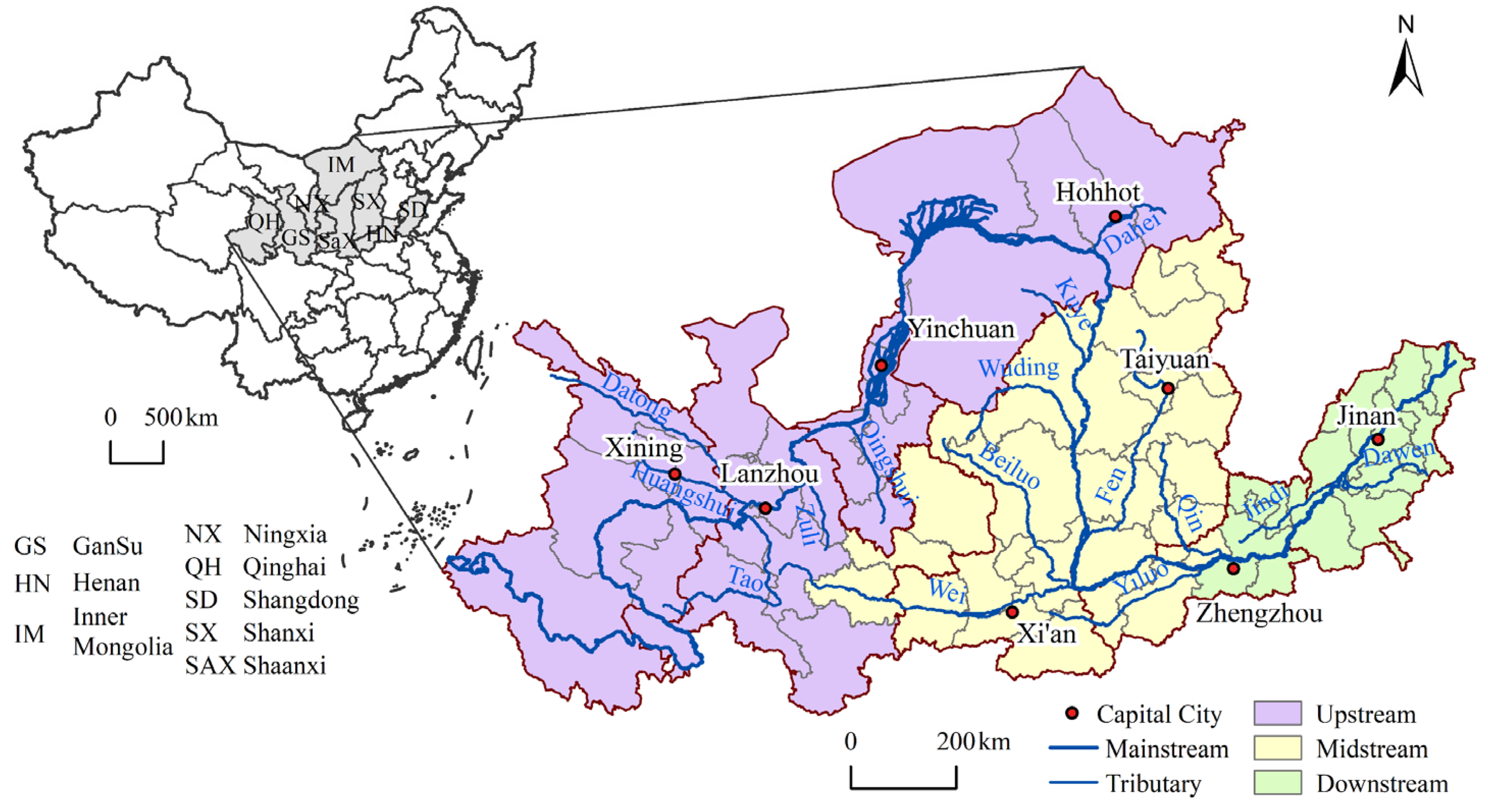
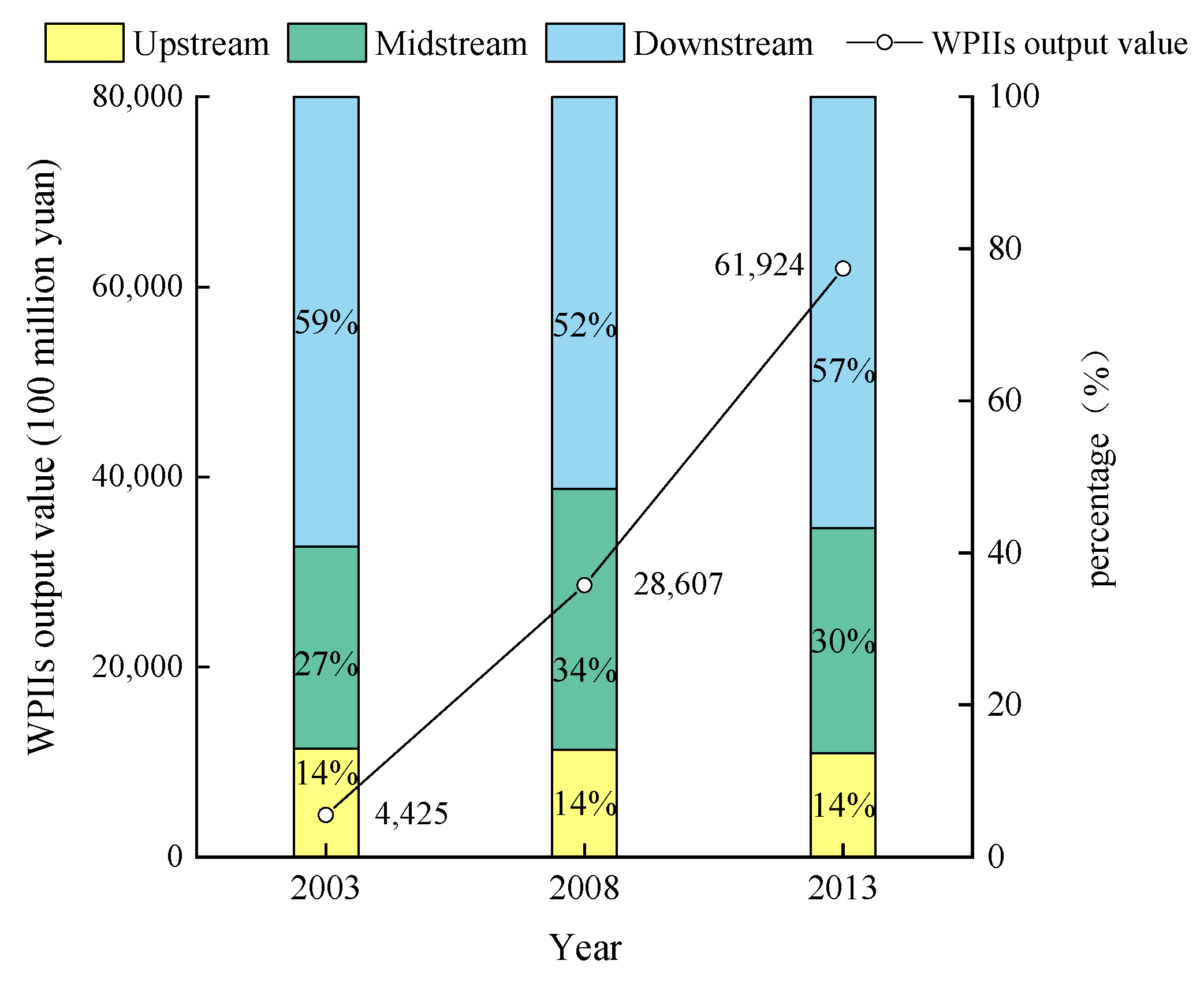
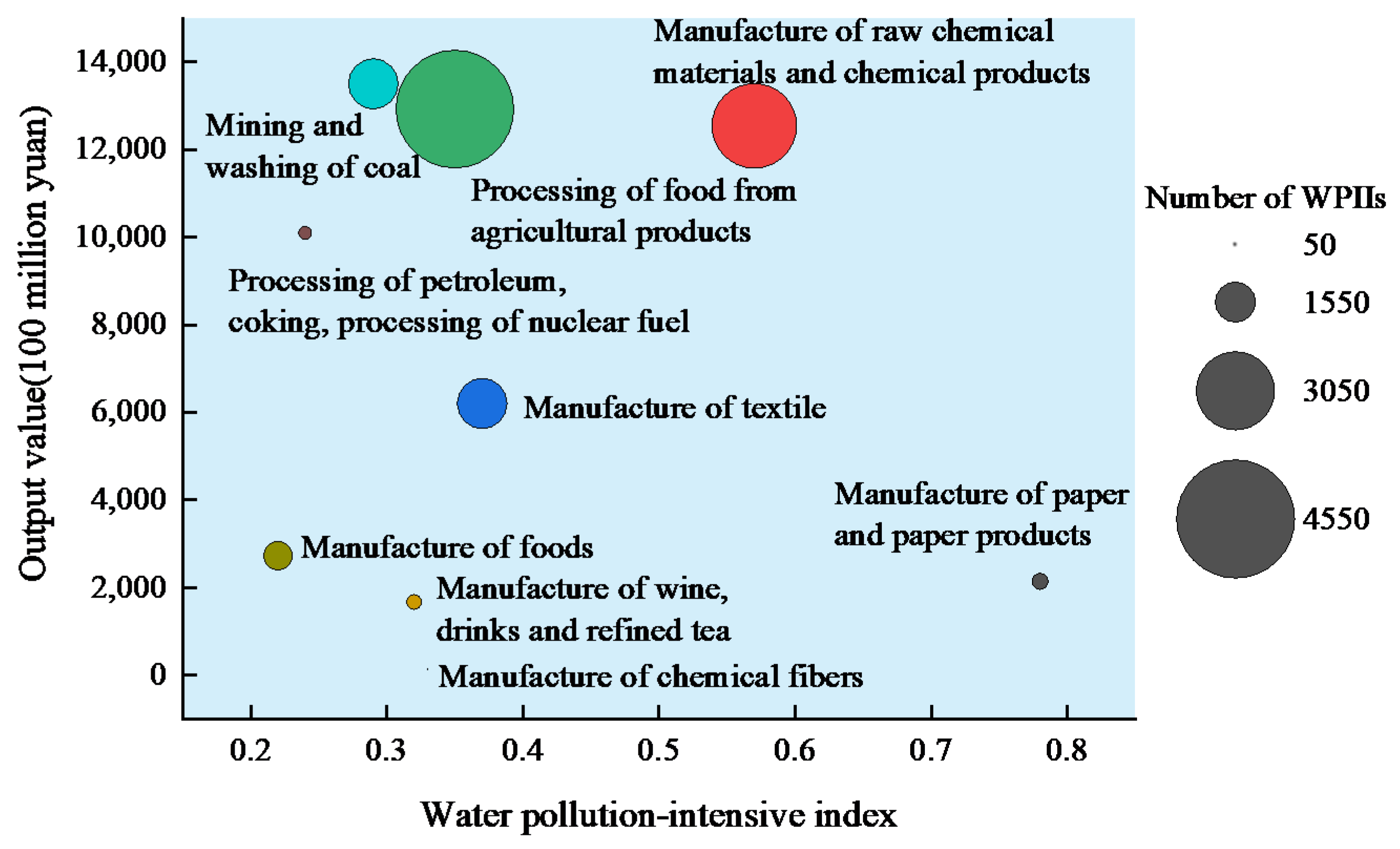
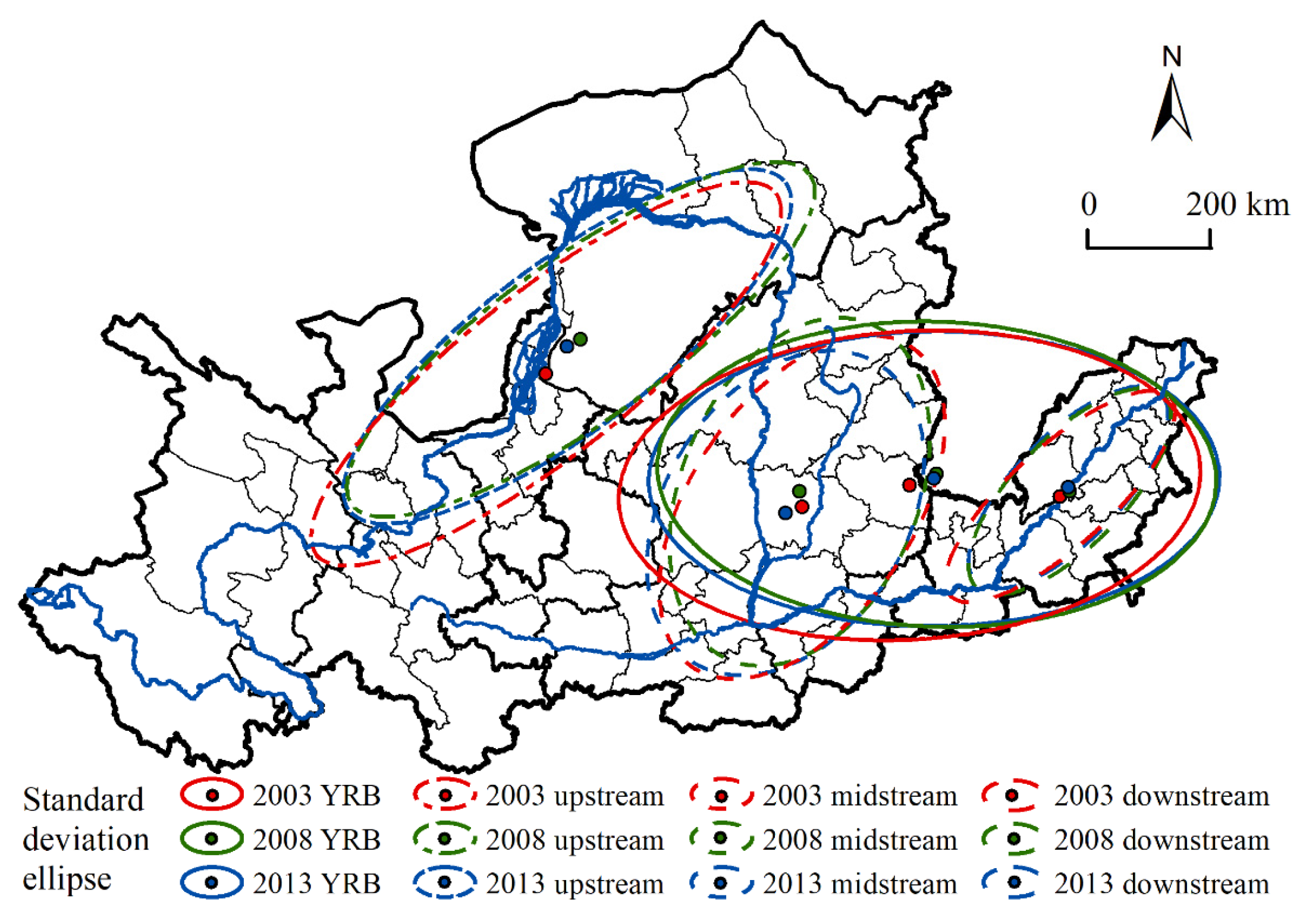
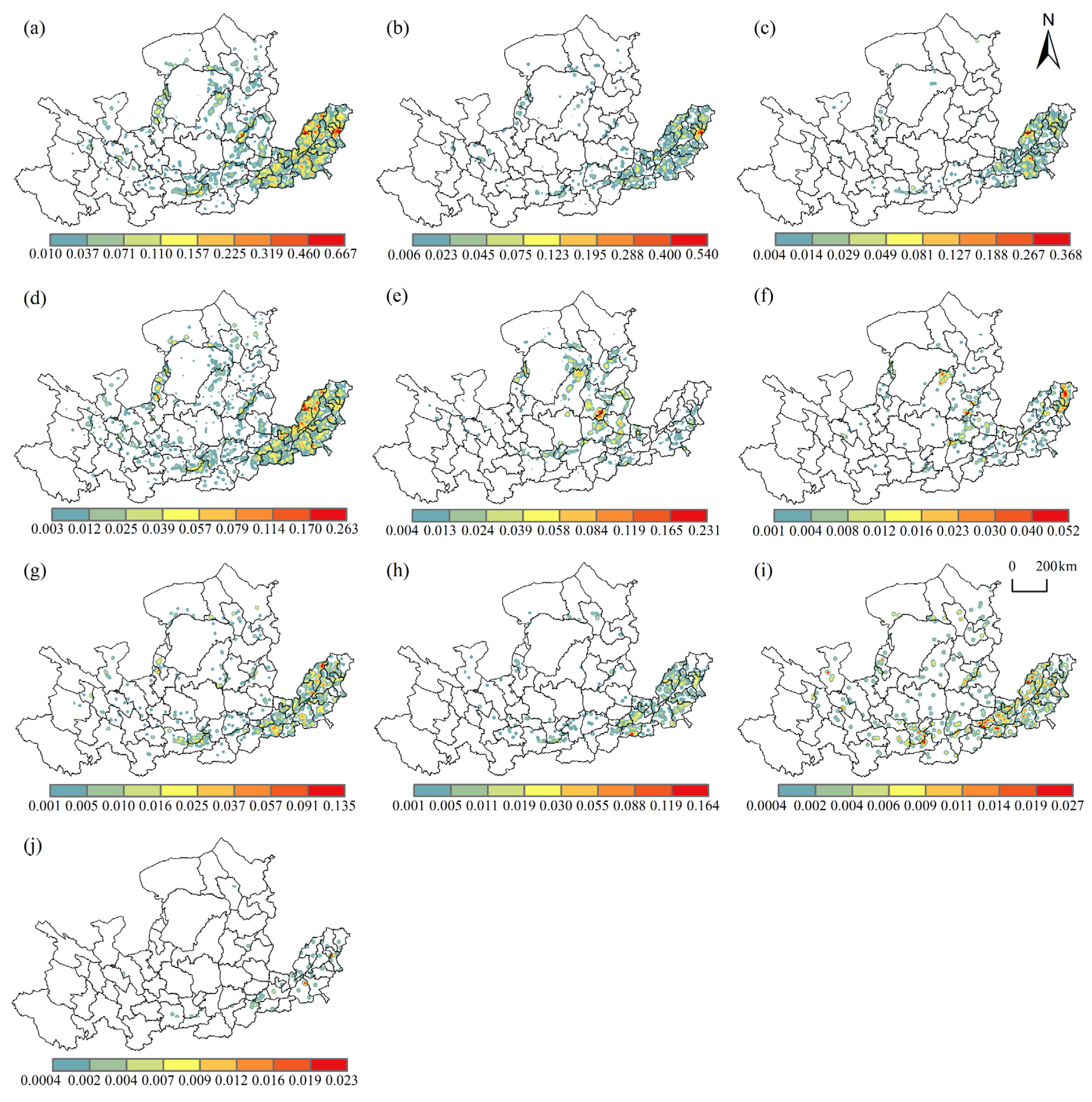

| Industry Code | Industry | I |
|---|---|---|
| 22 | Manufacture of paper and paper products | 0.78 |
| 26 | Manufacture of raw chemical materials and chemical products | 0.57 |
| 17 | Manufacture of textiles | 0.37 |
| 13 | Processing of food from agricultural products | 0.35 |
| 28 | Manufacture of chemical fibers | 0.33 |
| 15 | Manufacture of wine, drinks and refined tea | 0.32 |
| 06 | Mining and washing of coal | 0.29 |
| 25 | Processing of petroleum, coking, processing of nuclear fuel | 0.24 |
| 14 | Manufacture of foods | 0.22 |
| Main Tributaries | Number of WPIIs | Main Tributaries | Number of WPIIs |
|---|---|---|---|
| Main stream of the Yellow River | 1970 | Wuding River | 25 |
| Huangshui River | 73 | Fen River | 483 |
| Datong River | 13 | Wei River | 390 |
| Tao River | 11 | Beiluo River | 42 |
| Zuli River | 16 | Yiluo River | 193 |
| Qingshui River | 32 | Qin River | 183 |
| Dahei River | 54 | Jindi River | 424 |
| Kuye River | 114 | Dawen River | 322 |
| Category | Factors | Definition | Abbreviation | MEAN | MAX | MIN | SD |
|---|---|---|---|---|---|---|---|
| Resources endowment | Labor capital | Average wage of labor (yuan) | LC | 45,446 | 256,877 | 8407 | 40,397 |
| Natural resource endowment | Number of employees in the mining industry (10,000 people) | EMI | 3.8485 | 20.72 | 0.0008 | 4.8529 | |
| Technological innovation | Science and technology expenditure (10,000 yuan) | TI | 28,120 | 172,649 | 409 | 30,980 | |
| Socio-economic | Economic development level | Per capita GDP (Yuan) | PGDP | 46,927 | 256,877 | 8407 | 40,397 |
| Industrial structure | Proportion of secondary industry (%) | IS | 52.95 | 74.78 | 25.60 | 11.77 | |
| Pollutant discharge | Industrial wastewater discharge scale | Industrial wastewater discharge (10,000 t) | IWD | 4708 | 15,921 | 26 | 4073 |
| River proximity | Minimum distance of WPIIs to rivers (km) | MD | 29,388 | 105,466 | 41 | 27,707 | |
| Externality and transportation | Foreign investment | Utilization of foreign capital (USD 10,000) | FI | 37,919 | 332,178 | 0 | 65,875 |
| Transportation | Location quotient index of the amount of freight traffic (%) | TRAN | 7.73 | 42.34 | 0.13 | 7.19 |
| Factors | Coefficient Estimation | Standard Deviation | VIF |
|---|---|---|---|
| LC | 0.002 | 0.015 | 2.107 |
| EMI | −3.877 * | 20.102 | 1.643 |
| TI | 0.011 * | 0.005 | 3.881 |
| PGDP | 0.011 ** | 0.003 | 2.766 |
| IS | 3.646 * | 7.550 | 1.364 |
| IWD | 1.364 ** | 0.029 | 2.391 |
| MD | 0.003 * | 0.003 | 1.265 |
| FI | −0.009 | 0.002 | 3.704 |
| TRAN | 0.005 | 1.141 | 3.363 |
| R2 | 0.702 |
| Serial No. | Coefficient | Value |
|---|---|---|
| 1 | Best bandwidth size | 64.00 |
| 2 | Residual sum of squares | 14,765,541.49 |
| 3 | −2 log-likelihood | 1000.29 |
| 4 | Classic AIC | 1034.72 |
| 5 | AICc | 1047.83 |
| 6 | BIC/MDL | 1072.40 |
| 7 | CV | 501,133.71 |
| 8 | R square | 0.83 |
| 9 | Adjusted R square | 0.75 |
Publisher’s Note: MDPI stays neutral with regard to jurisdictional claims in published maps and institutional affiliations. |
© 2022 by the authors. Licensee MDPI, Basel, Switzerland. This article is an open access article distributed under the terms and conditions of the Creative Commons Attribution (CC BY) license (https://creativecommons.org/licenses/by/4.0/).
Share and Cite
Du, H.; Ji, X.; Chuai, X. Spatial Differentiation and Influencing Factors of Water Pollution-Intensive Industries in the Yellow River Basin, China. Int. J. Environ. Res. Public Health 2022, 19, 497. https://doi.org/10.3390/ijerph19010497
Du H, Ji X, Chuai X. Spatial Differentiation and Influencing Factors of Water Pollution-Intensive Industries in the Yellow River Basin, China. International Journal of Environmental Research and Public Health. 2022; 19(1):497. https://doi.org/10.3390/ijerph19010497
Chicago/Turabian StyleDu, Haibo, Xuepeng Ji, and Xiaowei Chuai. 2022. "Spatial Differentiation and Influencing Factors of Water Pollution-Intensive Industries in the Yellow River Basin, China" International Journal of Environmental Research and Public Health 19, no. 1: 497. https://doi.org/10.3390/ijerph19010497







